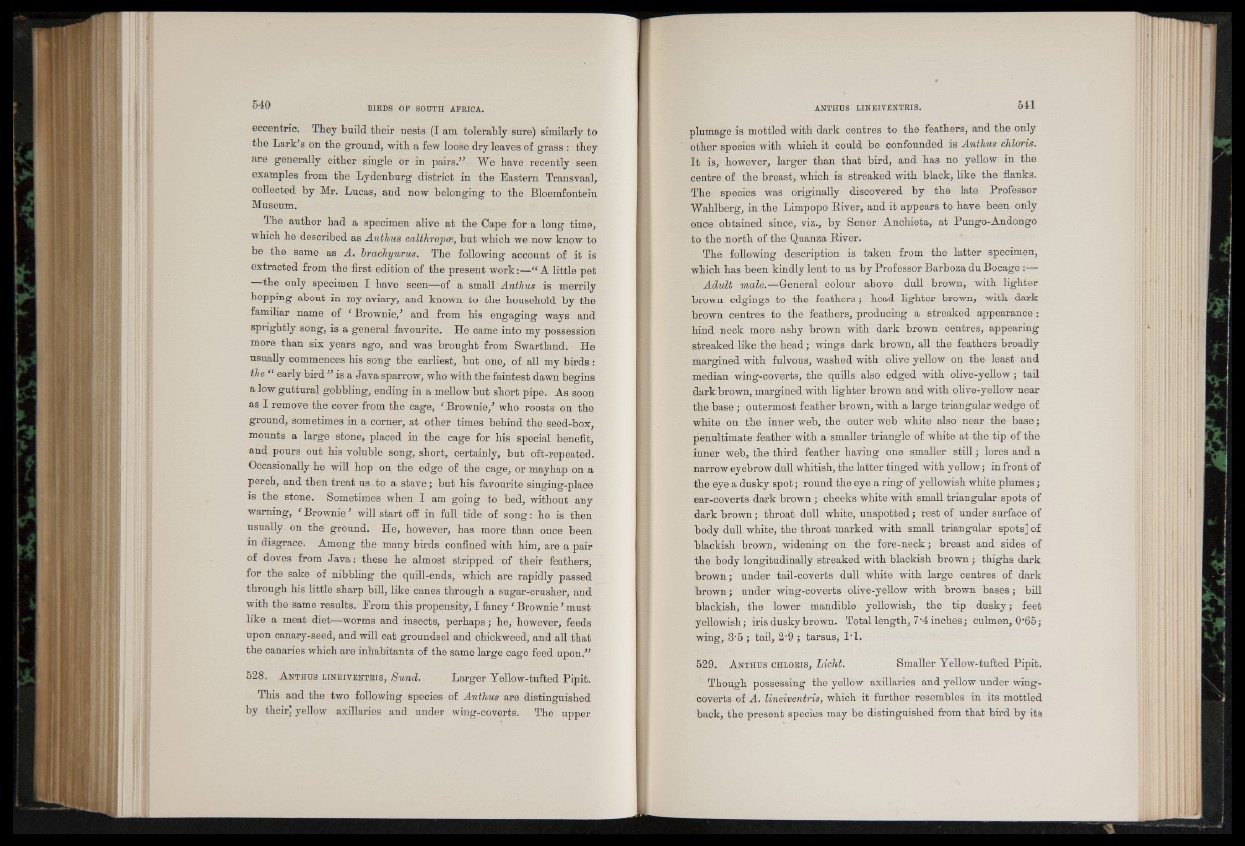
eccentric. They build their nests (I am tolerably sure) similarly to
the Lark’s on the ground, with a few loose dry leaves of grass : they
are generally either single or in pairs.” We have recently seen
examples from the Lydenburg district in the Eastern Transvaal,
collected by Mr. Lucas, and now belonging to the Bloemfontein
Museum.
The author had a specimen alive at the Cape for a long time,
which he described as Anthus calthropce, but which we now know to
be the same as A. brachyurus. The following account of it is
extracted from the first edition of the present work:—“ A little pet
the only specimen I have seen—of a small Anthus is merrily
hopping about in my aviary, and known to the household by the
familiar name of | Brownie,’ and from his engaging ways and
sprightly song, is a general favourite. He came into my possession
more than six years ago, and was brought from Swartland. He
usually commences his song the earliest, but one, of all my birds :
the “ early bird ” is a Java sparrow, who with the faintest dawn begins
a low guttural gobbling, ending in a mellow but short pipe. As soon
as I remove the cover from the cage, ‘ Brownie,’ who roosts on the
ground, sometimes in a corner, at other times behind the seed-box,
mounts a large stone, placed in the cage for his special benefit,
and pours out his voluble song, short, certainly, but oft-repeated.
Occasionally he will hop on the edge of the cage, or mayhap on a
perch, and then treat us to a stave; but his favourite singing-place
is the stone. Sometimes when I am going to bed, without any
warning, f Brownie ’ will start off in full tide of song: he is then
usually on the ground. He, however, has more than once been
in disgrace. Among the many birds confined with him, are a pair
of doves from Java: these he almost stripped of their feathers,
for the sake of nibbling the quill-ends, which are rapidly passed
through his little sharp bill, like canes through a sugar-crusher, and
with the same results. From this propensity, I fancy ‘ Brownie ’ must
like a meat diet—worms and insects, perhaps; he, however, feeds
upon canary-seed, and will eat groundsel and chickweed, and all that
the canaries which ai’e inhabitants of the same large cage feed upon.”
528. A n th ijs l in e iv e n t r is , Sund. Larger Yellow-tufted Pipit.
This and the two following species of Anthus are distinguished
by their, yellow axillaries and under wing-coverts. The upper
plumage is mottled with dark centres to the feathers, and the only
other species with which it could be confounded is Anthus chloris.
It is, however, larger than that bird, and has no yellow in the
centre of the breast, which is streaked with black, like the flanks.
The species was originally discovered by the late Professor
Wahlberg, in the Limpopo River, and it appears to have been only
once obtained since, viz., by Senor Anchieta, at Pungo-Andongo
to the north of the Quanza River.
The following description is taken from the latter specimen,
which has been kindly lent to us by Professor Barboza du Bocage:—
Adult male.—General colour above dull brown, with lighter
brown edgings to the feathers; head fighter brown, with dark
brown centres to the feathers, producing a streaked appearance :
hind neck more ashy brown with dark brown centres, appearing
streaked like the head; wings dark brown, all the feathers broadly
margined with fulvous, washed with olive yellow on the least and
median wing-coverts, the quills also edged with olive-yellow; tail
dark brown, margined with fighter brown and with olive-yellow near
the base ; outermost feather brown, with a large triangular wedge of
white on the inner web, the outer web white also near the base;
penultimate feather with a smaller triangle of white at the tip of the
inner web, the third feather having one smaller still; lores and a
narrow eyebrow dull whitish, the latter tinged with yellow; in front of
the eye a dusky spot; round the eye a ring of yellowish white plumes;
ear-coverts dark brown ; cheeks white with small triangular spots of
dark brown; throat dull white, unspotted; rest of under surface of
body dull white, the throat marked with small triangular spots] of
blackish brown, widening on the fore-neck; breast and sides of
the body longitudinally streaked with blackish brown; thighs dark
brown; under tail-coverts dull white with large centres of dark
brown; under wing-coverts olive-yellow with brown bases; bill
blackish, the lower mandible yellowish, the tip dusky; feet
yellowish; iris dusky brown. Total length, 7‘4 inches; culmen, 0'65;
wing, 3'5 ; tail, 2-9 ; tarsus, l ’l.
529. A n th u s ch lo r is, Licht. Smaller Yellow-tufted Pipit.
Though possessing the yellow axillaries and yellow under wing-
coverts of A. lineiventris, which it further resembles in its mottled
back, the present species may be distinguished from that bird by its